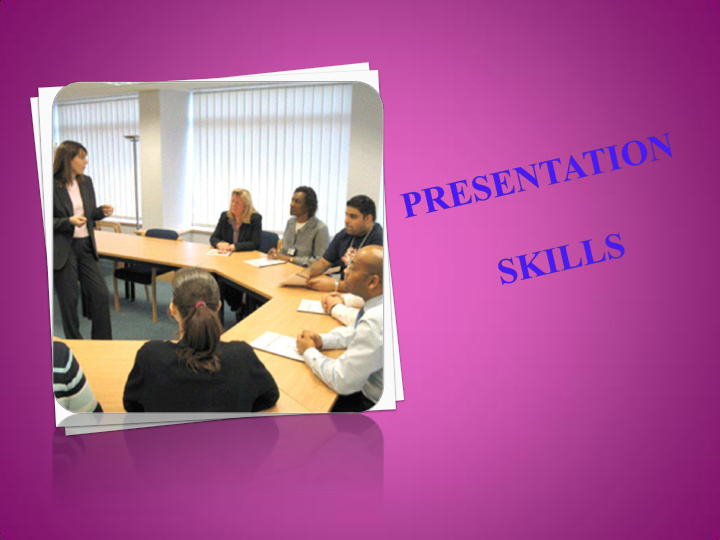



Presentation is the practice of showing and explaining the content of a topic to an audience or learner. The purpose of the presentation in this setting may be to either demonstrate candidates' skills and abilities in presenting, or to highlight their knowledge.
Organize The Talk Design The Slides Preparing For The Presentation
Read The Entire Paper At Least 3 Times Find The Important Ideas Create a Talk Outline
Slide Organization Summarize Main Points It Is Okay To Waste Space A Picture Is Worth A Thousand Words
Provide A Talk Road-Map Repeat The Point Explain Concepts In Our Own Words Talk To The Audience
Do not put both hands in your pockets for long periods of time. This tends to make you look unprofessional. It is OK to put one hand in a pocket but ensure there is no loose change or keys to jingle around. This will distract the listeners. Speak to the audience...NOT to the visual aids, such as flip charts or overheads. Also, do not stand between the visual aid and the audience. Speak clearly and loudly enough for all to hear. Do not speak in a monotone voice. Use inflection to emphasize your main points.
Get to the presentation before your audience arrives; be the last one to leave. When writing on flip charts use no more than 7 lines of text per page and no more than 7 word per line (the 7 x 7 rule). Also, use bright and bold colors, and pictures as well as text. Consider the time of day and how long you have got for your talk. Time of day can affect the audience. After lunch is known as the graveyard section in training and speaking circles as audiences will feel more like a nap than attending a presentation.
PRESENTATION SKILLS By M.MADHUBALA
ORAL PRESENTATION An oral presentation is a form of oral communication. It is a participative two way communication process characterised by the formal and structured presentation of a message using visual aids. It is purposeful and goal-oriented. Thus an oral presentation is purposeful, interactive, formal, audience oriented.
EFFECTIVE PRESENTATION SKILLS Frame work for effective teaching practice : Technique(skills) + Style(individual expression) = Effective presentation A good presentation has four elements: Content Structure Packaging Human element
PLANNING THE PRESENTATION Planning the presentation is, thus, the most important element. It involves purpose identification, audience analysis, analyzing the occasion. It includes : Define the purpose. Analyse the audience. Analyse the occasion. Choose a suitable title.
PREPARING FOR A PRESENTATION Preparing a presentation is like preparing any other assignment. It needs to be planned researched and written before it is delivered. Getting started Timing
ORGANISING THE PRESENTATION The opening of the presentation should convince the audience to listen to it. Functions: Get the audience’s attention. Introduce the subject. Give the audience a reason to listen. Establish the credibility and Preview the main ideas.
REHEARSING THE PRESENTATION Rehearsal should be planned and conducted properly and systematically. Strategies: Plan the rehearsal. Rehearse before a live audience. Timing during rehearsal. Recreate the presentation environment.
GIVING THE PRESENTATION Starting well Stand in a balanced position, facing the audience, feet apart. Greet the audience and introduce yourself. Delivery Written and spoken language are different. Speak clearly and at a moderate pace. Don’t read your presentation word-for- word from a script or from PowerPoint slides
Tips for avoiding performance anxiety: Stand in a balanced position. Take a deep breath. If you feel nervous, remember that your audience consists of your colleagues and friends.
Courtesy Clarity Conciseness Concreteness Correctness Consideration Completeness
Courtesy is gentle politeness and courtly manners. It is a behavior marked by polished manners or respect for others and act or expression
A characteristic of a speech or a prose composition that communicates effectively with its intended audience. The quality of being expressed clearly, the ability to think about or understand something clearly.
Expressing much in few words; clear and succinct. A characteristic of a speech or prose composition in which a great deal is conveyed in just a few words.
Concreteness is an aspect of communication that means being specific, definite, and vivid rather than vague and general. A concrete communication uses specific facts and figures. Counselors, attorneys, job interviewers, etc. often prod their interviewees to speak with greater concreteness.
It is defined as conforming or agreeing with fact, logic, or known truth and freedom from error .
Consideration is the concept of legal value in connection with contracts. It is anything of value promised to another when making a contract. It can take the form of money, physical objects, services, promised actions, abstinence from a future action, and much more.
Completeness is defined as having all necessary or normal parts, components, or steps.
Seminars are an interactive method of group teaching, which usually enables an audience to gain maximum knowledge. Audience interaction with the seminar tutor allows for debate and discussion based on new ideas generated from listeners. This in turn leads to a more proactive, interesting session in which both the audience and the tutor have a learning experience.
seminars play a significant role in simulating the thought process. They induce people to exchange new information that would not have been available. When a seminar is conducted at its best, the purpose of the gathering is fully met. It is imperative to keep in mind the essentials of conducting an effective seminar. The main ones are: efficient public speaking, which uses good voice modulation, tone and content; the right presentation method; and rehearsal, which means practicing the way the seminar will be presented by taking infront of the mirror.
Introduction Illustrating Your Arguments Preparing Yourself For The Presentation
Play to your strengths. Pick a class that is built upon a type of activity that you enjoy. Spread the words. You will learn more deeplyabout the focal topic by describing your seminar to others and by processing their questions and observations. Make eye contact with your audience. Maintain good body language.
Recommend
More recommend